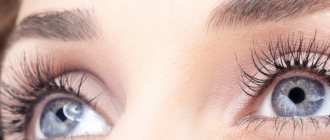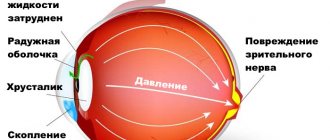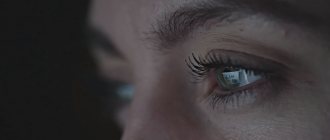What is dry eye syndrome?
When an ophthalmologist prescribes glasses, he must carefully measure the center-to-center distance - from the center of the bridge of the nose to the center of the pupil.
Sometimes there is a practice where an optometrist measures the distance for one eye and makes glasses, believing that it is similar for the other. But this is very often wrong, since our face is asymmetrical. The consequence is that the center of one eye receives a section of the lens whose curvature is greater compared to the center of the other. This leads to a distortion of the image before the eyes and causes the eye muscles to become more tense. The interpupillary distance must be determined on both sides. This data is entered into the recipe.
If the distance is measured incorrectly, then accommodation is impaired. The eyes are constantly trying to converge towards the center. At the same time, the muscles responsible for the movement of the eyeball are tense. A person feels their spasm in the form of painful sensations in the head area. If such glasses are worn for a long time, strabismus may develop.
There are cases when the prescription is written out correctly, but in optics, when choosing glasses, only the appearance that the client wants and the matching optical power of the lenses are taken into account. All this will lead to the wrong choice of glasses.
You must order glasses strictly following the prescription, and only from a highly qualified ophthalmologist. Modern eye clinics can offer many different frame designs. They have all the necessary equipment and high-class specialists.
This is one of the most common reasons. This is due to the fact that people do not go to an ophthalmologist, but go to an optical store and buy glasses without a prescription. As a rule, standard glasses have lenses with the same optical power, but often the vision impairment in both eyes is not equal. In this case, the eye, the disturbances in which do not correspond to the optical power of the lens, will become overstrained, which will lead to headaches. Only a doctor can draw up the correct prescription, which will contain the required data.
In this case, the frame squeezes the head. The pressure, of course, is not significant, but with prolonged wear, compression of the superficial temporal arteries occurs. This entails impaired blood circulation in the anterior part of the superficial tissues and cerebral vascular spasm. My head hurts very badly. This may cause darkening of the eyes, loss of consciousness and dizziness.
As soon as the frame stops pressing, the symptoms immediately disappear. To avoid such troubles, you should always try on glasses before purchasing. If you feel the slightest feeling of discomfort, especially in the temporal region of the head, you should refuse the purchase.
Narrow lenses
Recently, glasses with narrow lenses have become very fashionable. They only partially cover the field of view. This is very bad, because the eye either tenses (when you are not looking through the lens) or relaxes (if you look through the lens). This constant change in load leads to eye fatigue and headaches.
Deterioration of vision
If you have not replaced your glasses, and the pain has recently appeared, the reason may be that your vision has changed. It is worth contacting an ophthalmologist who will do a full examination and issue a new prescription.
1. Most lenses double the image.
2. Lenses can transmit different amounts of light. This increases astigmatism.
3. Incorrectly sized frames. Similar to glasses for vision correction.
Glasses from specialized stores, although more expensive, are absolutely safe. Products must be certified. Not only will they not cause headaches, but they will also protect your eyes and eyelids from the sun, preventing the appearance of wrinkles.
The best way to prevent headaches while wearing glasses is to select them correctly. Contact a specialist. Be sure to go to an ophthalmologist with your glasses prescription, and not to the nearest optical store. There is a chance that they will not have a model that will suit you. You will waste money, suffer from pain, completely ruin your eyesight, etc. You begin to notice correctly selected glasses only when they fog up when entering a room or become dirty for some other reason.
You need to take your health seriously. If something bothers you, be sure to go to the doctor. Especially when it affects quality of life issues. If you have a headache, it can have an extremely negative impact on your performance.
Contact lenses have become affordable today, and operations to restore vision are safe and effective. Unfortunately, in some cases such approaches are prohibited. Some people just prefer wearing glasses. Many even made them part of their image. You just need to remember the nuances of using products that have become so widespread.
Most often, the causes of headaches when wearing glasses are the result of violation of the rules for selecting or wearing an accessory by the person himself. Sometimes negative consequences result from a medical error or manufacturing defect. It is important to remember that if you get a headache from wearing glasses, you cannot tolerate this condition! Trying to eliminate cephalalgia with pills will not be beneficial. The clinical picture will only worsen and be supplemented with new symptoms.
People who prefer to use such products should not skimp on accessories. Inexpensive options for sunglasses are not able to cope with the functions assigned to them. According to statistics, up to 60% of economy class models pose a risk to vision.
Risks of using cheap sunglasses:
- the lenses are unevenly darkened, so they transmit different amounts of light - this can increase or cause astigmatism;
- some glasses double the image, forcing the eyes to strain to give the picture the desired quality - this leads to deterioration of vision;
- Cheap frames often do not meet basic anatomical requirements, which leads to disruption of blood flow in certain areas of the head.
To purchase sunglasses, it is better to contact optical stores. Such products cannot be cheap, but if selected correctly they will last for several years. An additional advantage of such models is their ability to protect the delicate skin around the eyes from ultraviolet radiation. This reduces the risk of wrinkles forming in this area.
The fact that a headache appears after purchasing a new pair of glasses should be brought to the attention of the ophthalmologist. The specialist will conduct diagnostics, identify the causes of the problem and give recommendations on the selection of products. To prevent cephalalgia caused by deterioration in the quality of vision, it is necessary to visit an ophthalmologist at least once a year and change glasses if necessary.
A headache after purchasing a new accessory does not always indicate problems. Sometimes it occurs out of habit, so it does not require adjustments to the specialist’s instructions.
Headache? Are your fingers going numb? To prevent a headache from turning into a stroke, drink a glass.
If headaches are a consequence of adaptation to a new model of glasses, then they can be dealt with in the following ways:
- general and acupressure head massage;
- frequent rest - every hour for 5 minutes with eyes closed;
- inhaling aromatic oils or rubbing peppermint ether into whiskey;
- gymnastics for the eyes, which alternates tension and relaxation of the visual organs;
- drinking chamomile or lemon balm tea, which can relieve muscle tension.
It usually takes from several hours to a couple of days to adapt to new accessories. If the headache persists longer, you should visit a physician or ophthalmologist. You should not try to relieve cephalalgia with anti-inflammatory drugs or analgesics. This can lead to addiction and the appearance of abusive headaches.
The discomfort that occurs when wearing glasses and is constant, leads to decreased attention, mood swings, and chronic fatigue. Systematic headaches can cause depression and risk becoming chronic. If you contact a specialist about the problem in a timely manner, you will be able to get rid of the symptom in just a couple of days.
Not every person can boast of good eyesight, so some are forced to wear glasses regularly. If they are chosen correctly, then, as a rule, you do not have to deal with side effects. In other situations, people often get headaches from glasses. In such a situation, it is important to know the causes of the phenomenon so that the situation can be corrected.
Sunglasses are one of those few accessories that go well with any style of clothing and are perfect for both young boys and respectable men.
But not every representative of the stronger sex admits that after wearing sunglasses, headaches and a feeling of fatigue in the eyes often appear. As a rule, men themselves simply do not pay attention to such side effects.
Meanwhile, ophthalmologists assure that pain symptoms often bother fans of this accessory, especially if the choice is made on cheap models.
can be described as pressing pain, burning, tingling, throbbing in and around the eye.
It may be characterized by a foreign body sensation. Eye pain can range from barely perceptible discomfort to unbearable, severe pain.
The duration, nature and location of pain depend on the cause.
There are a number of reasons why pain in the head and eyes can be a sign of dangerous diseases.
Overwork is the most common cause of pain in the head and eyes. A condition during which the head and eyes begin to hurt after long hours of working at the computer, a hard day or stress is called tension headache. In this case, pain in the head appears on both sides and the pain is not very strong and quite tolerable. Feels like a squeezing, tight hat.
Why do glasses cause headaches: causes and treatment
Man lives in a world of modern technology and innovation. For many people, it is common to use a computer every day at work, read e-books at home, watch movies, and chat with friends on the Internet. Decreased vision is associated with sitting for many hours in front of a laptop.
If nearsightedness, farsightedness or astigmatism occurs, you have to buy glasses or use contact lenses. After hard working days, my glasses give me a headache.
Why is this happening? If a person sees poorly, he goes to the doctor to get a prescription for glasses. Properly selected optics help you see the world around you in all its splendor.
But for some unknown reason, headaches begin.
Why might glasses cause headaches?
Headaches for various reasons. Often my head hurts from incorrectly chosen glasses. Ailments are caused by migraines, brain tumors, injuries, poor nutrition and other factors. The causes of headaches when wearing contact lenses and glasses may be the following:
- incorrectly set interpupillary interval;
- distorted lens power in the frame;
- small oblong glasses;
- long-term use changes vision parameters;
- You may get headaches from wearing sunglasses.
The interpupillary distance is incorrectly determined
When selecting glasses and lenses, the ophthalmologist carefully measures the distance between the centers of the pupils of both eyes. There are cases when measurements are taken for one organ (from the middle of the pupil to the center of the bridge of the nose), ignoring the parameters of the other. It is believed that for the second eye it is similar.
Most people's faces are not completely symmetrical. A product made in this way distorts the visible image, since the curvature of the lens does not match, it is greater than for the other eye. The owner of such a frame constantly tenses his eye muscles to focus his vision. Result:
- your head starts to pound;
- strabismus develops.
Even if the doctor wrote out the prescription correctly, the client chooses the frame based only on its appearance. The discrepancy between the diopters of the glasses leads to the fact that they cause discomfort during use. The frame, which shifts on the face, also causes inconvenience.
Incorrect lens strength in glasses
Many people solve their vision problem in a simple way: they do not go to an ophthalmologist, but buy ready-made frames without examination. In such products, the optical power of the lenses is incorrectly selected.
Finished frames are made to an average standard: they do not take into account the individual characteristics of the client’s eyes. The strength of the lenses in the frame is the same. People's vision deteriorates differently in both eyes. Deviations in glass cause headaches.
Small frame
Painful sensations occur if the frame for constant wear is small and compresses the temporal lobes of the head. Blood circulation is disrupted and vasospasm occurs. A person's vision becomes dark, fainting and dizziness occur. My head starts to hurt.
Changing vision settings
After wearing glasses for a long time, my head starts to hurt. With age, visual acuity changes. It gets better or worse. In this case, you need to see a doctor to check your eye parameters. The ophthalmologist will conduct an examination, after which he will write a prescription for the necessary lenses.
Headaches when using sunglasses
In the summer and spring, sunglasses are used to prevent wrinkles. They protect the organs of vision from bright sunlight. Many people prefer to buy cheap accessories that cause pain. They cause irreparable damage to the eyes. Research has shown that inexpensive frames with solar control lenses:
- The resulting image is doubled.
- Lenses transmit different amounts of sunlight. Astigmatism may subsequently develop.
- The accessory was selected independently. Interpupillary distance is not taken into account.
How to get rid of headaches when wearing glasses?
Headaches are caused not only by fatigue, overexertion, and physical activity. The cause may be incorrectly selected glasses or lenses.
The client complains of pain if:
- Vision correction was performed incorrectly. Both overcorrection and “weak” glasses that do not eliminate visual discomfort are cause for concern. In this case, visit an ophthalmologist to find out the cause of the ailment.
- Patients who, along with myopia or farsightedness, have astigmatism, complain. The ophthalmologist did not take this factor into account. He prescribed glasses with regular lenses. During work and reading, the eye muscles experience constant overstrain, which causes headaches. Cylindrical (toric) glasses are prescribed for low degrees of astigmatism. People who have nearsightedness or farsightedness along with astigmatism purchase spherical glasses with a toric component.
- When selecting glasses from an ophthalmologist, the center-to-center interval is incorrectly measured for the patient. Removing the parameters of one eye leads to the fact that the curvature of the sphere does not coincide with the center of the second eye. The picture before your eyes is distorted, your muscles are constantly tense: your head starts to hurt. When taking measurements, make sure that measurements are taken on both eyes.
- The tight frame squeezes the temples. Blood circulation is disrupted, which causes pain and fainting. Glasses slip off or press on the bridge of your nose. The problem is eliminated by adjusting the temples or nose pads. After such manipulations, the optical centers of the glasses are restored in relation to the pupils along a vertical line. Eliminating the cause leads to a normal state, discomfort disappears, and the headache stops.
- Glasses with narrow lenses with constant use cause discomfort and soreness of the eye muscles. Remember that they are suitable for reading, they should not be worn regularly.
- Many people experience photophobia and have to wear sunglasses. Cheap accessories let in ultraviolet rays, which can cause headaches. To preserve vision, sunglasses are purchased at pharmacies or specialty stores. They have certificates and their use is safe for the client. They will be able to protect your eyes from intense solar radiation and will not cause headaches.
- Eye disease (glaucoma) at an early stage of development does not cause painful symptoms. During an attack, intracranial pressure increases. Pain appears in the area of the eye sockets, moving to the temporal part of the head. They are accompanied by a decrease in vision.
Interesting: Headache before menstruation: causes, treatment, prevention
When choosing glasses, the patient should take into account the above factors. They will help prevent discomfort.
In order not to provoke pain, glasses must be selected carefully. If muscle tension or discomfort occurs, make an appointment with an ophthalmologist and have your vision checked. It is necessary to take into account the fact that vision changes over time.
Source: https://golovaibolit.ru/prichiny-golovnyh-bolej/pochemu-bolit-golova-ot-ochkov-prichiny-i-lechenie
Headache as an allergic reaction to lenses
It's so tempting to get rid of glasses without surgery. It is enough to purchase contact lenses, which have long been used to correct vision-related pathologies.
Their use has many positive aspects, since your interlocutor may not even suspect that you have some shortcomings. In addition, lenses are much more compact than glasses; to wear them you do not always need to take a bulky case with you.
They are also often used for decorative purposes.
On the other hand, lenses require careful care and need to be replaced over time. Quite often, after starting to wear contact lenses, a person develops a headache of varying intensity. And he doesn’t know how best to act in this situation. Why do lenses give me headaches? The main factors that contribute to the occurrence of an unpleasant symptom are identified.
There are several pathological mechanisms that lead to the development of headaches some time after starting to wear contact lenses. The main reason is the incorrect selection of lenses by the ophthalmologist. As you know, each lens has a certain refractive power, which is measured in diopters.
And if a person wears contact lenses for a long time, with a greater refractive power than he needs, this leads to tension and spasm of the eye muscles. Clinically, this condition is manifested by a nagging headache, rapid fatigue even with average eye strain (reading, writing, working with a computer).
A similar mechanism for the development of pathology occurs when the patient independently, without consulting an ophthalmologist, chose contact lenses.
Also, patients often buy two similar lenses, not knowing that an individual approach is almost always required for an individual eye, since the difference in their refraction is sometimes very significant.
Another reason for the development of headaches from wearing contact lenses is that they are incorrectly selected for the patient in size, without taking into account individual anatomical features. In this case, they exert constant pressure on the eyelids, eyelashes and conjunctiva. Constant irritation also leads to infections and the development of inflammatory processes.
Dry eye syndrome is no less common. Its appearance is due to the fact that the lens has the ability to dry out and absorb liquid from the surface of the conjunctiva.
Usually, to avoid this complication, ophthalmologists advise regularly moisturizing your eyes 3-4 times a day using regular drops. If this is not done, many patients develop dry keratitis.
Its clinical symptoms intensify if the patient has decreased tear production or spends a long time in dusty rooms. In addition, the risk of developing a complication increases when the following conditions are observed:
- long-term work with a computer;
- vitamin A deficiency in the diet;
- previous injuries and eye surgeries;
- at high altitudes (when flying in an airplane);
- constant use of air conditioning;
- dry hot climate;
- with frequent smoking;
- windy weather conditions.
People with hypersensitivity, asthma, atopic dermatitis, urticaria or rhinitis often develop an allergy to contact lenses.
Modern and expensive lens models are made entirely of hypoallergenic material. But since such products have a high price, many people prefer cheaper analogues.
Typically, the clinical picture develops in the second week of wearing lenses. And a clear connection can be observed between the severity of clinical symptoms and the use of contact lenses. It manifests itself as redness of the conjunctiva, burning of the eyes, as well as aching pain in the head.
Many patients believe that the price of contact lenses in specialized ophthalmology stores and centers is overpriced, so they buy them on dubious Internet portals or in stalls in bazaars.
Doing so puts your eye health at potentially serious risk. No one can give a guarantee or say with complete certainty whether these products are made of high-quality material.
Therefore, it is impossible to predict the body’s reaction when wearing products of dubious quality for a long time.
The first thing to do is stop using lenses. In most cases, after this the clinical picture disappears within two days. To quickly relieve symptoms, you can take non-steroidal anti-inflammatory drugs (NSAIDs). The most popular and effective of them are:
- Ibuprofen;
- Paracetamol;
- Aspirin;
- Ketanov;
- Meloxicam.
Statistics show that about a third of patients in ophthalmology clinics completely refuse to wear contact lenses within two years. This is due to various reasons: improper selection, infectious complications, dry eye syndrome and poor quality of the material. All of them are accompanied by headache symptoms.
Remember that low-quality lenses or choosing them yourself lead to irreversible consequences for the eyes. Corneal ulcer, keratitis, blepharitis is an incomplete list of pathologies that are caused by contact lenses. You can learn more about headaches from lenses from the video.
If you wear self-selected glasses for a long time, your eyes begin to hurt due to inaccurate focusing of the glasses lenses. When the optical centers of lenses are far from each other, the eyeballs have to regularly overexert themselves, which in turn leads to fatigue.
Glasses cause eye pain due to the wrong choice of diopters, which is also a common reason for self-treatment. Sometimes doctors do the wrong visual acuity test. Ultimately, the lenses of the glasses have the wrong optical power.
When wearing glasses, pain in the eyes appears due to their use for other purposes. When a doctor writes a prescription, it indicates what the glasses are intended for: work, constant wear, long-distance vision.
Incorrectly selected contact correction means cause migraine attacks, sometimes the head is painfully tense in the parietal region. Unpleasant symptoms are not always associated with the eyes. The reason why lenses cause headaches is due to improper care of the optics. Infection factors:
- putting on and taking off with dirty hands,
- insufficient sanitation of the storage container;
- rare change of disinfectant solution;
- wearing for many hours (natural dust, development of pathogenic microflora).
Interesting: Headache after a long sleep: causes, prevention, treatment
Another cause of pain associated with the eye is blepharospasm. Constant tension and frequent blinking cause a dull pain in the occipital and frontal parts of the head. There are other factors that can cause cephalgic syndrome.
If your head bothers you from time to time, it is better to clarify the dioptric parameters. It happens that the right and left eyes need different corrections. When wearing the same diopters, unproductive loads arise, which spasm the blood vessels of the head.
When worn for a long time, your head may hurt from too incorrect optics. Vascular spasms occur, blood flow is disrupted, and brain tissue experiences oxygen starvation. When age-related farsightedness develops, regular vision correction is necessary for people suffering from myopia. The head becomes heavy from too powerful or too weak vision correction products. Vision deteriorates from constant stress and poor nutrition.
Nasal swelling is mistaken for eye pain. An allergic or infectious runny nose provokes increased lacrimation. When the frontal part of the head hurts, it is associated with the influence of optics. Taking antihistamines and treating the infection leads to the elimination of unpleasant symptoms.
Allergies can be caused by the material used to make contact optical devices. If the pain in the frontal part of the head does not go away after a week, you should abandon contact optics. Polymers can cause dermatitis and corneal ulcers.
Factors causing painful syndrome:
- prolonged exposure to a monitor screen;
- low air humidity (this is typical in winter);
- consequences of surgical interventions;
- long flights;
- pathology of the lacrimal canaliculus (natural wetting does not occur);
- harmful working conditions (dust, smoke).
Interesting: Why do you get a headache after walking outside in the fresh air?
When head spasms bother you, accompanying symptoms arise: discomfort in bright light, a feeling of a foreign body in the eye.
The polymer material from which contact optics is made absorbs moisture from the cornea, which causes it to dry out. The syndrome, which causes pain in the frontal part of the head, can be eliminated with special eye drops.
Painkillers are not the answer. Complications are possible in the form of dry keratitis, when the structure of the cornea is disrupted. As a preventive measure, the diet should be adjusted; dry eye syndrome often occurs due to a lack of vitamin A.
When your head bothers you, pay attention to the symptoms that indicate the wrong choice of lenses:
- blurred image, clouding;
- fast fatiguability;
- pain in the eyes after hours of straining;
- facial muscles are constantly tense;
- increased tearfulness;
- loose fit.
The contact correction device must fit snugly to the membrane of the cornea; this is necessary for comfort. Correct selection of lens type involves determining:
- radius of base curvature (degree of curvature of the cornea);
- hemisphere diameter.
Keratometry is carried out using special equipment; the right and left eyes have different curvatures (BC). It is necessary to select lenses taking into account the parameters specified in the prescription. In humans, BC parameters vary in the range of 8.3–8.5 mm. Contact correction products are produced in the range of 7.5–9.5 mm. If the discrepancy between BC values is 0.3 mm, lenses should be individually made to prevent headaches.
Why do eyes hurt from glasses?
Today, the modern world cannot be imagined without smartphones, tablets and computers, so many are interested in why their eyes hurt when wearing glasses.
Often, this question is asked by office workers, those who like to spend time reading books, and people who wear glasses for image.
As a rule, every person must know that to avoid pain in the eyes when wearing glasses, they must be selected by a qualified specialist, otherwise the consequences may become irreversible.
Inaccurate focusing of spectacle lenses
If you wear self-selected glasses for a long time, your eyes begin to hurt due to inaccurate focusing of the glasses lenses. When the optical centers of lenses are far from each other, the eyeballs have to regularly overexert themselves, which in turn leads to fatigue.
© shutterstock
Rash actions lead not only to eye pain from glasses, but also to more serious vision problems.
Signs
- Fast fatiguability;
- Headaches and eye pains.
Treatment options
Only a doctor should select correction means, so it is worth visiting a qualified specialist.
Wrong choice of dioptres
Glasses cause eye pain due to the wrong choice of diopters, which is also a common reason for self-treatment. Sometimes doctors do the wrong visual acuity test. Ultimately, the lenses of the glasses have the wrong optical power.
© shutterstock
Recently purchased glasses
Sometimes it happens that pain appears in the eyes when wearing glasses that were recently purchased. This is faced by people who wear corrective eyewear for the first time or those who were forced to change glasses due to changes in vision.
© shutterstock
Uncomfortable frame
When your eyes hurt from glasses, the cause is often an uncomfortable frame.
© shutterstock
Misuse
When wearing glasses, pain in the eyes appears due to their use for other purposes. When a doctor writes a prescription, it indicates what the glasses are intended for: work, constant wear, long-distance vision.
© shutterstock
Sunglasses
Often, eye pain occurs after wearing sunglasses. This is due to disrupted lens manufacturing technologies, which include :
- Incorrect selection of materials;
- Defects in coating application.
© shutterstock
Doctors treating gas pain from glasses
When your eyes hurt after wearing glasses, the only specialist who has the power to fix it is an ophthalmologist. Today, in medicine, such a doctor is also called an ophthalmologist.
Both specialists specialize in the diagnosis and treatment of vision problems.
Less popular causes of eye pain from glasses
Other causes of eye pain from glasses include:
- Poor quality special computer glasses;
- Age;
- Congenital pathologies;
- Asthenopia;
- Astigmatism.
Incorrect vision correction and incorrectly selected glasses
Selecting eyeglasses can be simple or complex. In the first case, glasses are selected to correct myopia and farsightedness, in the second - to correct astigmatism and presbyopia. Regardless of the type of spectacle optics, to select it you will need to go through several procedures:
- visometry - determination of visual acuity;
- autorefractometry - assessment of the condition of the cornea and refraction - the ability of the eye to refract light rays;
- trying on glasses.
Two weeks after selection, it is recommended to visit the clinic again for a follow-up examination.
— For dark skin, it is recommended to choose frames in warm colors: red, tortoiseshell, copper, coral, creamy, peach, golden, honey, orange, khaki, beige.
— Pale skin is suitable for frames in cool colors: white, amethyst, steel, purple, pale pink, gray, blue, plum, silver, jade, anthracite.
Only by taking into account all these recommendations can you hope that glasses will not become an inferiority complex for you, but a stylish and desirable accessory that emphasizes your individuality.
— For brown-eyed people, it’s better to opt for lilac, tortoiseshell (black and red), red or coffee frames.
— For those with hazel eyes, we can recommend emerald-colored frames.
— Gray and blue eyes will harmonize with frames of brown, dark blue, or steel color.
If you consider these tips for choosing frames, you will be surprised at how beautiful and stylish your glasses will look on your face.
For example, daytime lenses should not be used at night because, with prolonged use, they cause dry eyes, burning and pain radiating to the crown or temples as the eye muscles become overstrained.
Part One: Equipment Discomfort
Let's take a quick look at what goes wrong with the equipment.
Cinemas are a business whose owners actively think about profits, which means they strive to reduce costs as much as possible and increase revenues. Does this affect the 3D quality? Let's try to figure it out:
- When talking about the discomfort of 3D films, journalists (copying materials from each other) first of all write about the “conflict of accommodation and convergence.” What do these words mean?
When a person moves his gaze from one object to another, he first turns his eyes so that the object does not appear double - this is called convergence. Then it “focuses” by changing the curvature of the surfaces of the lens - this is accommodation. In life, the points of convergence and accommodation coincide and are located on the object. The conflict between accommodation and convergence when viewing 3D is that we should always see the image clearly - the point of accommodation (focus) is on the screen, while the point of convergence can move to objects flying into the hall and off the screen.There is certainly a problem, but it is interesting that it is less critical for cinemas than for home TVs and especially 3D laptops and tablets. For example, in a cinema, at a distance of 15 meters from the screen, the spread of the visible depth of objects is conditionally from 7 meters to infinity (i.e., the “sharpness setting” is almost always set to “infinity”), and when viewed on a laptop screen it is 40 centimeters from the screen, the conventionally comfortable range is from 30 centimeters to infinity. Obviously, in the second case, the difference in eye focusing is much larger, more noticeable and potentially more uncomfortable.
Conclusion: “The conflict of accommodation and convergence” is certainly a fundamental problem of 3D, but it stimulates going to the cinema rather than vice versa, since according to this parameter (with high-quality content, of course), 3D is more comfortable the further the screen is from the viewer.
- The situation with the so-called active glasses is more indicative.
Active glasses alternately block the image for the right and left eyes. The eyes receive the image only from their own angle, which allows them to form a three-dimensional image. The advantage of such a system for the hall owner is that there is no need to change the (expensive) screen and sometimes there is no need to change the (also quite expensive) projector. It is enough to install a system for synchronizing the glasses with the projector (special infrared diodes that illuminate the screen), arrange for charging the batteries and wiping the glasses. (By the way, you can safely save money on the latter! ;).
The problem is that such systems have several significant disadvantages. Firstly, many viewers see flicker even though it is of high frequency. Manufacturers are trying to do something about it, of course. In particular, for 3D TVs there are models where the frequency is raised to 200 Hz, but this increases the cost of the equipment (including glasses). Secondly, it is really atypical for the brain to see an image with either the right or the left eye. This significantly adds to fatigue. The Japanese conducted an excellent study, the statistical significance of which is undeniable: they forced 500 volunteers to watch 3D and 2D with active glasses and very convincingly proved that the main share of fatigue is caused by active glasses, i.e. When watching 2D films, people got just as tired [1]. Thirdly, alternating display produces a time shift of half a frame (at best, a little less). Based on a frame rate of 24-25 frames per second and FullHD resolution, you can calculate the shift in pixels yourself if the main character lowers his hand vertically across the frame in half a second. The problem is that our eyes see a completely impossible picture, when in one eye the movement is noticeably delayed relative to the other and “the hands are in different places.” Note that for horizontal movement, this shift leads to the fact that an object moving faster (slower) than the background falls through (moves forward) depending on the direction of camera movement. Again, a picture impossible in real life. And finally, active glasses seriously reduce brightness. Yes, ideally the drop is only two times, but it would be two times if in open mode the glasses let in 100% of the light (which is not true), if they were perfectly synchronized (which is again not true) and if instantly changed their state (which again is not the case). In harsh reality, for example, glasses are in the open state for noticeably less time than in the closed state, in order to facilitate synchronization, etc. As a result, the active glasses of TVs from a very famous Korean company reduced the brightness by 7 (seven!) times. If the brightness of the screen is insufficient, then the eyes begin to strain, trying to see the details and... get tired quite quickly. And this is in addition to fatigue from the flickering itself. But that's not all! Active glasses also weigh noticeably more. This is especially important for those who already wear glasses, and who have to put one pair of glasses on top of another and watch a movie with two glasses. Those who suffer the most are the owners of expensive glasses, who are accustomed to the convenience and light weight of regular glasses.
Conclusion: Take care of your health! Don't go to cinemas with outdated active glasses! And if you are unlucky enough to have a TV at home with active glasses, watch 3D on it only in a darkened room, turning off all light sources, incl. energy-saving lamps (they sometimes interfere with the flickering of glasses, significantly aggravating fatigue and increasing the chances of a “3D migraine”).
- The importance of high 3D brightness was discussed above. In general, if you read professionals, they constantly write about brightness and fatigue from “dark 3D”. The magazine Projectionist in No. 3 for 2013 cited measurements of the luminous efficiency of 3D systems made by Alexander Musinov [2]:
System Brightness, foot-lambert XpanD AD1000 6,3 Master Image Clarity3D SA 9,7 Master Image Wave3D 6,2 Master Image DUAL3D 10,1 RealD XL 9,4 Dolby 3D 2,2 It is clear that the measurements were carried out in a specific hall, with specific systems, but now you know that the brightness in the same hall with different projector-glasses systems can vary by 5 times, even if we exclude IMAX systems from consideration (the brightness of which is only the cost of two projectors can be twice as much, and there are also their patented especially bright lamps!).
I hope it becomes clear why IMAX is valued? As practice shows, people are quite weak in distinguishing changes in quality even by tens of percent, but they still see and appreciate a difference in brightness of 10 times. By the way, remember the measurement result for Dolby 3D, it will be useful to us below. With passive glasses (Dolby 3D or RealD) the situation is better, but also not ideal. In particular, the display is almost always from one projector, in front of which a special attachment is placed, ensuring sequential display of the image for the left and right eyes. With this approach, flickering is preserved, and hence the headache associated with them for some people), however, the noticeability of flickering and the drop in brightness is less. But people still complain. By the way, for RealD polarized glasses it is necessary to change the screen to a more expensive one, which is essential for gym owners (Dolby 3D allows you to save on changing the screen, which we will remember again).
- And finally, what people love about IMAX halls is that they have passive glasses and two projectors: for the left and right eyes.
This means there is no flickering (most immediately felt better) and the screen brightness is at least twice as physically higher (also immediately less fatigue). At the moment, these halls are of the best quality. BUT! And here in our harsh reality, not everything is good. In particular, in the spring of 2014, in all IMAX halls, even in Moscow, which is relatively rich by Russian standards, linear polarization was used, and not circular (as in many IMAX halls, for example, in the USA). This means that when the head is tilted 45 degrees, the viewer sees the left and right angles of the image in each eye simultaneously with equal brightness. When tilted by 15 degrees, the other angle “shines through” by about a third. The translucency effect is called crosstalk and it is believed that its maximum value for comfortable viewing is about 2% [3]. As an exercise, you can remember school trigonometry and calculate how many degrees you can tilt your head. I’ll tell you right away - it’s a very small number. So it’s better for you to sit perfectly straight, and not as you are usually used to. In general, tilting your head when viewing a stereo is, in principle, not the best idea, since the image is formed for a person sitting upright and when tilted, the so-called. vertical parallax (vertical shift). If you have glasses with circular polarization, then when you tilt your head only it appears, but if you have glasses with linear polarization, then both parallax and crosstalk (hello, discomfort!). The quality of some films especially depends on crosstalk. For example, in “Gravity” there are a large number of contrasting scenes - astronauts in space (white objects on a black background). In this situation, even a small crosstalk greatly interferes with the comfort of watching a movie. Nevertheless, radically higher brightness and the absence of flicker are two huge advantages, thanks to which people, focusing purely on their feelings, recommend IMAX to their friends. I note that the equipment of such halls is noticeably more expensive. Conclusions (in one batch): - The difference in brightness between IMAX and “other manufacturers” can reach 10 times (!), which fundamentally improves viewing comfort and reduces fatigue.
- When watching a movie, don’t be too lazy to look around and notice one or two projectors shining on the screen. If there is one (the most likely situation), then even with passive glasses you will have flicker and all the possible delights associated with it.
- Looking ahead a little - 3D films also differ in brightness, in the worst case - up to 5 times (!). Typically dark, for example, all “horror” films. Are you sure that it’s worth going to see them in 3D in a room with “dark” equipment (the brand of equipment is usually indicated on the glasses)? I would like to save you from additional unplanned suffering.
Occasionally, hall owners install a powerful projector in a small hall (called “as for yourself”), which noticeably increases the brightness of the screen. Find out if there are such halls in your city.
(Dolby uses spectrum division), as a result, the inscription has significantly different brightness for the right and left eyes (also “strobe”). It’s clear that your attention is focused on the center of the screen, so the inscription flickers somewhere in the periphery of your vision, irritating the brain throughout the entire session even for those who don’t know about it (oh, I’m afraid you won’t be able to go to some halls with Dolby 3D now! ;). Because when you know this, the exit sign starts to really irritate. Let's hope this will encourage hall owners to install signs so that they can be seen from the aisles (and, alas, the outer rows), and not from the center of the hall, as now.
Conclusion: The strobing is clearly visible. Simply closing your left and right eyes alternately is enough to see it clearly. With some training, you will understand that discomfort comes from strobing even without closing your eyes. Unfortunately, with the current quality of the gyms, such training will happen more often than we would like. Don’t hesitate to write online reviews about the hall if you see gating there. The owners of the hall will think about the problem only if you understand it and make it public.
| Name of 3D system | Total halls | Share |
| Dolby 3D | 1327 | 42,9% |
| XpanD 3D | 495 | 16,0% |
| Volfoni | 313 | 10,1% |
| MasterImage | 177 | 5,7% |
| RealD | 151 | 4,9% |
| IMAX | 32 | 1,0% |
| GM X-Mirror | 19 | 0,6% |
| Hi-Shock | 18 | 0,6% |
| Others/none | 561 | 18% |
| Total | 3093 | 100% |
43% is Dolby 3D (Why such a share? That’s right! The price of installing the system has a significant impact, as you remember, how does this affect brightness and flicker). 16% - XpanD 3D, and some of these halls are halls with active glasses (poor people...), 10% - Volfoni (can have both active and passive glasses), 5.7% and 4.9% each - MasterImage and RealD - fairly high-quality passive systems (conditionally - 10% together) and 1% - IMAX (the highest quality, but also expensive halls). At the same time, 18% falls on the “Other” category, in which there are many Chinese manufacturers. Unfortunately, people are not very knowledgeable about the subject and are sure that 3D in an expensive hall and 3D in a cheap one are the same. In practice this is not the case. You can calculate your chances of getting into a gym with good equipment yourself.
Do you need a conclusion? Fine! Re-equipping halls costs money and some people save money, while others decide to invest. If I were you, I wouldn’t skimp on my health and would only go to gyms with expensive, good equipment.
Unfortunately, there are even IMAX (i.e., tested before launch) theaters that have been converted from regular 2D ones and in which they decided to install seats in a wider area than the area for comfortable 3D viewing. In such halls it is definitely better to skip the premiere than to watch the film from the “wrong” seats. Conclusion: Watch 3D films only from the center of the hall, or as close to them as possible, even if the seats there are a little more expensive.
According to the author of the report, the condition of many 3D halls, even in Moscow, is extremely depressing. There were total savings on the quality of projectors, screens, lamps, glasses, chairs, regular equipment adjustments, etc. At the same time, the owners of the hall stated the same characteristics when they “invited” to organize the premiere in their hall, but in practice the characteristics (including brightness) turned out to be much lower. Briefly and constructively, we can recommend going to those halls that show premieres. In them, at least, the equipment is adjusted for the premieres, and for the same ticket price, the quality can be noticeably higher. At the same time, you need to soberly realize that one of the saving methods used by cinemas is to install more expensive and brighter lamps at the premiere, and then replace them with cheaper ones during regular screenings. Since good lamps are quite expensive, this also allows you to save money, unfortunately, by increasing the percentage of viewers who feel discomfort from 3D. Conclusion: Pay attention to which halls show premieres. Believe me, these halls are chosen, and the equipment there is adjusted more often.
The above is not a complete list of problems with 3D quality in cinemas. Unfortunately, equipment problems sometimes lead to excuses for poor quality of the material itself. From correspondence with a professional working for a major Hollywood studio:
“However, the bigger issues are the lack of consistency and quality in exhibition. There needs to be pressure put upon distributors and exhibitors to keep the bulbs bright, clean the eye-wear, and regularly measure the illumination from the screen. No matter how well we create S3D, it is getting lost in all too many theaters world wide.”
“However, the bigger problem is the lack of consistency and quality in the display. Pressure needs to be put on distributors and venue owners to keep brightness high, clean glasses, and measure screen lumen output regularly. No matter how well we make S3D, this quality will be lost in a huge number of cinemas around the world.”
Those.
The terrible quality of 3D theaters in cinemas really demotivates manufacturers to clean out small errors in stereo that arise at the production stage. All the same, they will be lost against the background of cheap Chinese equipment and poor setup in 99% of the halls. Fortunately, it's not all bad. In particular, the quality of 3D TVs and home theaters is rapidly improving. If what was offered as a great innovation for big money in 2010 is compared with what is offered as an additional, almost free option in 2014, then the contrast will be striking. For radically less money, radically higher quality is now offered. For example, models with “head-scratching” active glasses are gradually being replaced, crosstalk is decreasing, brightness in 3D mode is increasing, and in 4K TVs with passive glasses, half the lines of the stereo image are no longer lost - all this radically increases the comfort when watching TV. Moreover, in Russia, approximately 25% of sold TV models (virtually all top models) have the ability to display 3D. And in Asia today, the percentage of sold TV models with 3D support already reaches 75% (all models except the cheapest). As the Chinese state, not without pride, “It’s already difficult to buy a TV in a store without 3D support, you’ll have to look for one specifically!” At the same time, the quality in new models continues to improve. As a result, today the comfort when watching a good large TV screen with passive glasses in a dark room can be significantly higher than in an average cinema.
So if in your city the cinema halls only have cheap equipment (terrible dark 3D picture), the best solution would be to buy a modern TV with passive glasses (after looking at its characteristics and reading reviews). And the equipment in the halls will gradually be replaced, simply because new projectors for cinemas today, firstly, also support 3D en masse, and secondly, they do it better and better.
For example, a new trend is the emergence of so-called “laser projectors”. “Laser” models have already been offered by several projector manufacturers (including Chinese). IMAX makes its laser projectors. The key points are that they have very high brightness and initially only passive glasses. It is also important for hall owners that lasers last approximately 5-10 times longer than lamps in conventional projectors. As some professionals joke, “the dark times of 3D are ending with laser projectors.” Reviews from people who are attentive to visual effects who watched a film from a laser projector often sound in the vein of “I watched an old film as if it were completely new,” i.e. many details were simply not visible before. Don't expect too much soon; it looks like laser projectors will go through a few childhood illnesses before the quality becomes consistently high. However, expensive, high-quality laser projectors today actually make it possible to show film images with a quality unavailable only yesterday and solve many of the problems of 3D cinemas today.
And here content problems come to the fore, but this will be discussed in detail in the second part.
So, the main conclusions of the first part:
- In a huge number of halls, equipment is installed that allows you without changing the screen and projector
(i.e., as cheaply as possible). As a result, the viewer often sees a dark, flickering picture, which quickly leads to fatigue and headaches. - The highest quality picture is in IMAX 3D halls (higher brightness, no flickering, light and large glasses, large screen), but the number of such halls is small (about 1%), besides, even in Moscow they mostly install “IMAX for the poor”, with glasses with linear polarization.
- The vast majority of people are not aware that the 3D brightness in different halls can differ by 10 times, they don’t know how tired flickering can cause and how to look around and count how many projectors are in the hall, they don’t know what strobing is and how to detect it by eye, etc. .d. As a result, people first “grab what they give”, and then complain about a headache. In this situation, if you care whether you (and your loved ones) have a headache or not, it makes sense to understand the reasons and choose (and popularize in every possible way) only the right halls. Only this can stimulate the replacement of equipment with more expensive and higher quality ones. Exactly this, by the way, has already happened in the USA. As long as our people don’t care, there is no reason to even hypothetically consider replacing equipment with more expensive and advanced ones. Worse, there is no reason to pay even a small amount of money simply for periodic adjustments to the equipment. Sometimes even the focus simply “goes away” due to the vibration of the projectors and no one cares - my friend recently watched a 3D film in one of the halls of our cultural capital of St. Petersburg and says that he has never seen such horror in terms of blurriness of the picture. And it was clearly not the film. But obviously, people still go to this (by the way, not cheap) gym. Who cares when people suck?
- Another way to save on equipment is to buy used equipment. This is exactly how we have new 3D rooms with filthy, filthy glasses. Attentive comrades could notice such halls even in relatively rich Moscow. It is clear that, as a rule, these are outdated systems, with a poor price/quality ratio in terms of ticket prices (but good in terms of converting the hall into 3D).
- The only way to make gym owners think about the quality is to only go to gyms with the best equipment. Take care of yourself, value your head and your eyes, don’t go to bad 3D gyms.
Less headaches for everyone! And in life in general and from cheap 3D equipment in particular.
The period of getting used to new glasses
Often, when buying new glasses, people focus exclusively on diopters. However, this is not true. Your head may hurt when wearing second glasses if you did not pay enough attention to the following factors when purchasing them:
- Diopter difference for looking into the distance or in front of you. For example, the lens size is different for reading a newspaper and for distinguishing the number of an approaching bus.
- The presence of strabismus, a special note is made in the prescription for correction.
- Interpupillary distance.
Therefore, you should purchase a new accessory in specialized optical stores with a prescription.
New glasses can cause various unpleasant symptoms: headaches and eye pain, dizziness, increased fatigue. Some people complain about:
- enlargement or reduction of objects;
- changing the contours of visible objects;
- incorrect estimation of distance.
Often these symptoms go away within 7-10 days. It is necessary to give the eyes the opportunity to adapt to the new optics. The adaptation period depends on individual physiological characteristics and the type of glasses. Thus, astigmatic lenses are quite difficult for many people to tolerate. It takes longer to get used to such spectacle optics.
Uncomfortable frame
When your eyes hurt from glasses, the cause is often an uncomfortable frame.
Sometimes the cause of pain in the eyes is an incorrectly selected frame. It should be not only beautiful, but also comfortable. If the temples compress the temples too much, the head begins to hurt, as well as the eyes, and dizziness occurs. With very narrow glasses, the patient often has to look over the lenses, which leads to overstrain of the eye muscles.
How to choose comfortable glasses? The choice of frames today is more than varied. Try to evaluate as many models as possible until you find the perfect one. Contact a specialist who will help you choose frames based on your face shape. Having chosen a suitable model, try it on. Test your new glasses. Leave them on your eyes for 15-20 minutes. Make sure that the frame does not put pressure on your temples or slide down, and that the lenses provide high-quality correction.
Why do glasses cause headaches?
Various gadgets that have become an integral part of the life of a modern person sometimes do not have the most favorable effect on his health.
In particular, the need to constantly strain the eyes often leads to deterioration of vision and the need to correct it with glasses.
Ophthalmology has advanced significantly in recent years, which makes the use of accessories as comfortable as possible. Despite this, cases of headaches from glasses are not uncommon.
Some people do not even suspect that their constant or systematic cephalalgia is associated with wearing products. Many people ignore the symptom and try to cope with it on their own.
Over time, the problem acquires catastrophe proportions and only then do the victims turn to specialists. To prevent this situation, it is enough to purchase glasses according to your prescription, and not according to your feelings.
At the first signs of discomfort, you should contact a therapist or ophthalmologist, and not try to cope with the pain with medications.











